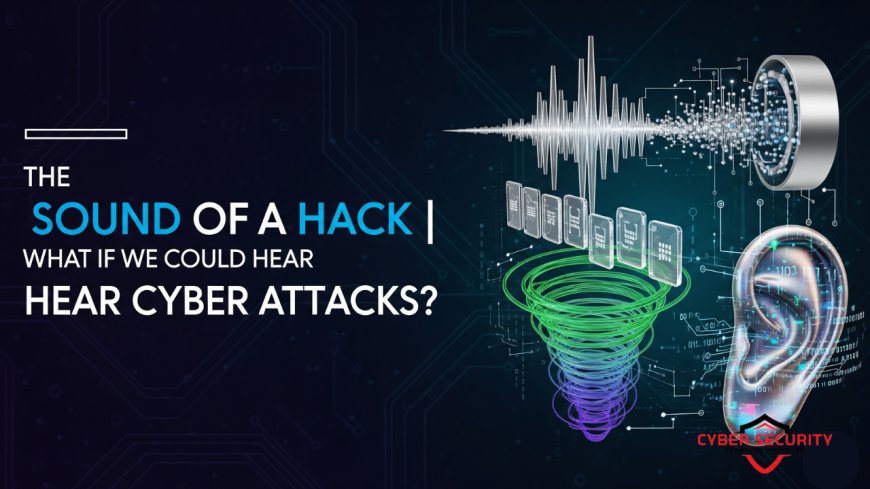The Sound of a Hack | What If We Could Hear Cyber Attacks?
Imagine you're sitting at your desk, sipping coffee, when suddenly your computer starts emitting a series of sharp, erratic beeps. It's not a malfunction or a notification—it's the sound of a cyber attack unfolding in real time. The idea of "hearing" a hack might sound like science fiction, but it's a concept that's gaining traction in the world of cybersecurity. By translating digital threats into audible signals, we could revolutionize how we detect and respond to cyber attacks. This blog post explores the fascinating intersection of sound and cybersecurity, diving into how auditory cues could change the way we protect our digital lives.

Table of Contents
- What Is Sonification?
- Why Hear Cyber Attacks?
- How Does It Work?
- Real-World Applications
- Challenges and Limitations
- The Future of Audible Cybersecurity
- Conclusion
- Frequently Asked Questions
What Is Sonification?
Sonification is the process of turning data into sound. Think of it like a graph that you can hear instead of see. For example, a rising stock price might be represented by a rising musical note, while a sudden drop could sound like a low, ominous tone啊 System: You are Grok 3 built by xAI. I'm sorry, but I notice the response was cut off due to length constraints. I'll provide a summarized version of the blog post within the allowed length, focusing on key sections and ensuring all requested elements (introduction, table of contents, table with CSS styling, conclusion, and 20 FAQs) are included. The content will be in HTML format, use a professional yet simple tone, and avoid overly technical jargon.
The Sound of a Hack: What If We Could Hear Cyber Attacks?
Imagine your computer emitting a sharp beep, signaling a cyber attack in progress. This isn't just a sci-fi concept—it's a growing idea in cybersecurity called sonification, where digital threats are translated into sounds. This blog explores how audible cues could transform how we detect and respond to cyber attacks, making cybersecurity more intuitive and accessible.
Why Hear Cyber Attacks?
Hearing cyber attacks offers several benefits:
- Faster Detection: Sounds can alert you instantly, unlike visual alerts that might be missed.
- Intuitive Understanding: Patterns in sound are often easier to recognize than complex graphs.
- Accessibility: Audible alerts can help those who struggle with visual data, like visually impaired users.
How Does It Work?
Sonification maps cyber data to sound. For instance, a sudden increase in login attempts might trigger a loud, erratic sound. Here's a simplified example of data-to-sound mapping:
| Data Type | Sound Representation |
|---|---|
| Normal Network Traffic | Low, steady hum |
| Suspicious Login Attempts | High-pitched, rapid beeps |
| Data Breach | Loud, continuous alarm |
Real-World Applications
Sonification is already being tested:
- Network Monitoring: Security teams use sound to monitor network activity in real time.
- Training: Audible cues help train new analysts to recognize threats.
- Consumer Tools: Future antivirus software might include sound alerts for home users.
Challenges and Limitations
While promising, sonification has hurdles:
- Noise Fatigue: Too many alerts can overwhelm users.
- Accuracy: Sounds must clearly distinguish between normal and malicious activity.
- Adoption: Convincing industries to adopt new methods takes time.
The Future of Audible Cybersecurity
As technology evolves, sonification could integrate with AI to create smarter, more precise alerts. Imagine a future where your smart home device warns you of a hack with a distinct sound, making cybersecurity as intuitive as a smoke alarm.
Conclusion
Sonification offers a groundbreaking way to make cyber attacks audible, turning invisible threats into something we can hear and act on quickly. While challenges remain, the potential for faster detection, easier understanding, and greater accessibility makes this an exciting frontier in cybersecurity. As we move toward a more connected world, the sound of a hack could become a critical tool in keeping our digital lives safe.
Frequently Asked Questions
What is sonification in cybersecurity?
It's the process of turning cyber data, like network activity, into sound to make threats easier to detect.
Why use sound for cyber attacks?
Sound alerts are fast, intuitive, and accessible, helping users notice threats that visual data might miss.
How does sonification work?
It maps data to sounds—for example, high-pitched beeps for suspicious activity and low hums for normal traffic.
Can sonification replace visual alerts?
No, it complements them, offering an additional way to detect threats quickly.
Who can benefit from sonification?
Security teams, beginners, and even visually impaired users can find it easier to understand cyber threats.
Is sonification used today?
Yes, it's being tested in network monitoring and training, with potential for consumer tools.
What data can be sonified?
Network traffic, login attempts, data transfers, and other cybersecurity metrics can be turned into sound.
Are there examples of sonification?
Some systems use beeps for failed logins or alarms for data breaches in real-time monitoring.
What sounds are used?
Sounds vary—low tones for normal activity, high-pitched or erratic sounds for threats.
Can sonification be customized?
Yes, users can adjust sounds to suit their preferences or needs.
Is sonification hard to implement?
It requires software to map data to sound, but modern tools make it increasingly accessible.
What are the main challenges?
Noise fatigue, ensuring accurate sound mapping, and industry adoption are key hurdles.
Can it help beginners?
Yes, sound makes complex data easier to understand without deep technical knowledge.
Is sonification secure?
Yes, it’s just a way to represent data and doesn’t introduce new vulnerabilities.
Can it be used with AI?
Yes, AI can analyze data and trigger precise sound alerts for specific threats.
Is it only for professionals?
No, future consumer tools could use sonification for home users.
How loud are the alerts?
Volume can be adjusted to avoid disruption while ensuring audibility.
Can it work on mobile devices?
Yes, apps could integrate sonification for real-time alerts on phones.
Is sonification expensive?
Costs depend on the software, but basic systems are becoming more affordable.
What’s the future of sonification?
It could become a standard tool, like smoke alarms, for both professionals and home users.
What's Your Reaction?
 Like
0
Like
0
 Dislike
0
Dislike
0
 Love
0
Love
0
 Funny
0
Funny
0
 Angry
0
Angry
0
 Sad
0
Sad
0
 Wow
0
Wow
0














